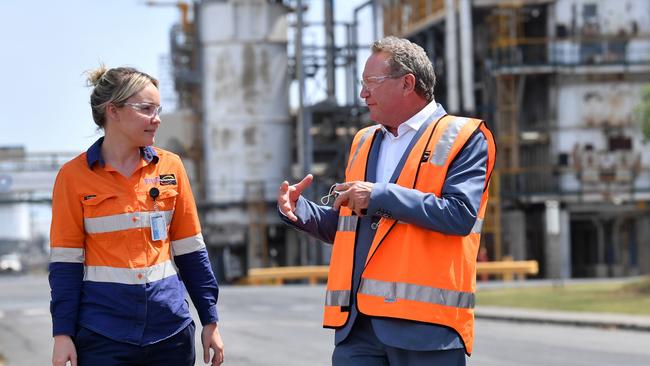
When Fortescue Metals chair Andrew Forrest speaks at the Queensland Media Club in Brisbane on Friday, all ears will be out for a major announcement from the Perth billionaire about a possible investment in renewable energy in Queensland.
Forrest, who was in Canberra earlier in the week, is on a visit to Queensland as part of his green energy campaign which took off in earnest in 2020 when he began travelling the world, signing up green hydrogen deals for Fortescue’s green energy subsidiary Fortescue Future Industries.
His enthusiasm for things green actually goes back further, to the forces which drove him to do a PhD in marine science at the University of Western Australia – which he completed in 2019 – leaving him with a passion for cleaning up oceans and other environmental initiatives he is pursuing through the charities of himself and his wife Nicola.
Forrest is one of the leading business people interviewed for the Australian’s first list of the 100 Green Power Players, which will be published in Friday’s paper.
The theme of the media lunch in Brisbane is “Queensland’s Green Energy Future” which will discuss ways to make the sunshine state a green energy powerhouse.
Just what Forrest, who has made his billions exporting iron ore to China, will announce is not clear at this stage.
Both his listed arm, Fortescue’s Fortescue Future Industries, and his rapidly growing private business empire, Tattarang, have green energy operations.
Run by former MLC chief Andrew Hagger Forrest’s private business arm owns many different operations with iconic Australian clothing company RM Williams being the best known.
The key energy arm is Squadron Energy which itself has several arms including a 15 per cent stake in Sun Cable, a venture with Atlassian co-founder Michael Cannon-Brookes through his private investment arm Grok Ventures, to export solar energy from Darwin to Singapore.
It also includes renewables company Windlab which is developing wind farms in Australia using the WindScape technology developed by the CSIRO and Australian Industrial Energy (AIE) which is developing an LNG importing terminal at Port Kembla.
When developed it is hoped the terminal could supply as much as 70 per cent of the gas needs of NSW. The first of its kind in Australia, the terminal is expected to be operational by mid-2023.
The project is the opposite of the three big LNG exporting terminals now underway in the Queensland port of Gladstone by the big global gas players.
One option for the Forrest group could be to have a similar LNG importing plant at the same port given it is already geared up for ships which can handle LNG.
Interestingly in the US, coastal terminals originally built for importing LNG have now been converted to export LNG gas from the US to the rest of the world.
But Forrest has so many green aspects to his operations his announcement could be in a number of different areas.
Forrest’s speech and a possible green energy deal in Queensland will cap off a big week for the energy sector which began with news on Sunday night of a surprise bid for AGL by a consortium involving Cannon-Brookes’ Grok and Canadian fund Brookfield.
A more detailed analysis of other top players in the green energy field will be made in what is being dubbed the “green rich list”.
Meanwhile in lower key event in Hobart on Wednesday, the University of Tasmania announced plans for its first green bond which will be managed by CBA and NAB, and is expected to be worth some $200m. The funds from the bond, which will go to market on March 2, are expected to be used to finance the university’s plans to consolidate its operations in Hobart CBD.
What is expected to be a 10- or 12-year fixed rate senior unsecured green bond will be used to support the financing of assets and projects by the university which are aligned to the 2021 Green Bond Principles of the International Capital Market Association.
The bond is believed to be the first green bond raised by an Australian university since 2018.
The University of Tasmania’s bond is part of a growing sector of green-related fundraising are used to finance the development of sustainable projects.
The market for green, or more broadly sustainable, financing is exploding in the rest of the world.
Ratings agency S&P Global, is expecting total sustainable bond issuance this year to surpass $US1.5 trillion ($2.07 trillion).
Green bonds will make up a significant part of this with investors in Europe and the US expected to lead markets globally.
While Australia is playing catch up, deals such as that announced by the university are a sign of the growing market locally.
The university said: “Green bonds are designed to play a leading role in the investment market, enabling funds to be directed to projects that deliver positive environmental outcomes.
“As part of our commitment to sustainability and in recognition of the urgency of the climate crisis and the need to limit warming to 1.5 C, we are committed to support the development of a zero carbon economy.
“While most jurisdictions globally are grappling with the challenge of decarbonising electricity generation, this is not the case for Tasmania with one of the lowest carbon electricity grids in the world with its primary energy source being hydro-electric.
“Given this, the university has decided the most impactful pathway for our contribution to decarbonisation is to reduce upfront embodied carbon embedded within our building program and focus on leading transformation of the construction industry.”
The green bond commits it to a minimum target of a 20 per cent cut in upfront carbon emissions in the construction of the new campus buildings in Hobart.
Given all these events in one week, one can only wonder what the Australian’s Green Power Players list of 2023 might look like.

